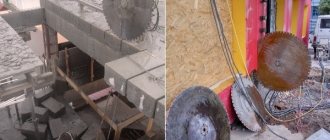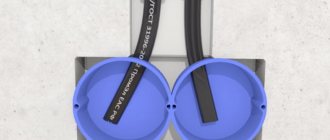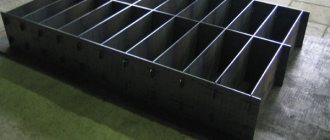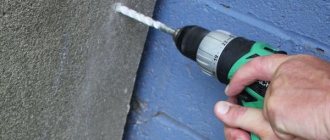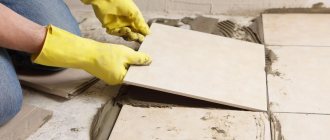Sooner or later, each of us gets tired of the usual environment of a house or apartment and a natural desire comes to change it somehow by remodeling the living space. This event involves partial modification of the walls or their complete demolition. In this lesson we will tell you how to break a wall correctly depending on the material from which it is made and what tools you will need for this.
Having chosen, in your opinion, the ideal option for redevelopment, you must obtain permission to carry it out from the relevant government authorities. Without their written consent, redevelopment will be considered illegal, which in the future may complicate the sale or re-registration of housing.
Remember that changes to the walls during redevelopment can cause them to shift, which can lead to disruption of the stability of the house and other unpredictable consequences. In any case, before breaking a concrete or brick wall, you should consult with construction professionals.
What walls can be dismantled?
Load-bearing walls are the fundamental elements of the structure; they serve as supports for the floors, so breaking them is prohibited. You can demolish conventional partitions made of the following materials:
- brick,
- concrete,
- foam block,
- stone,
- tree,
- drywall.
Their thickness usually does not exceed 38 cm.
If the repair affects internal partitions and walls - complete or partial demolition, formation or filling of openings - you first need to make sure that prior approval from the housing inspection is not required. Permission is not required in situations where manipulations affect only non-load-bearing structures.
In this case, the redevelopment will be legalized after the work has been completed. But there are exceptions: listed houses and buildings with wooden floors. In such a situation, before starting work, it is necessary to submit to the residential technical inspection a conclusion on the condition of the structure and the safety of the planned intervention. In relation to load-bearing walls, regulatory authorities can only give permission to construct an opening.
How to determine if a wall is load-bearing or not?
A wall that is planned for demolition or an opening may turn out to be load-bearing. Such concrete walls provide the building with the required structural rigidity and integrity. Only the architectural (structural) plan of the building can give an actual answer. At the same time, there are general principles based on which it is possible to partially solve the problem. So, the load-bearing walls are the walls of the outer perimeter of the structure and those facing the entrance. Load-bearing walls also include walls shared with neighboring apartments.
Others are difficult to identify on your own. For example, in monolithic buildings, walls 20 cm thick can be supporting, or partitions can be thicker than 20 cm. The structures of frame-monolithic structures often do not have load-bearing vertical surfaces. Modern construction projects implement architectural and design solutions that do not allow one to unambiguously determine the purpose of the wall without reading the documentation. In early panel buildings it is also difficult to determine whether a wall, for example, 10 or 14 cm thick, is a load-bearing wall or a reinforced partition.
In some projects, almost all vertical structures are load-bearing. An objective answer will be given only by authorized specialists and project documentation for the house. A positive conclusion on the technical reconstruction project opens the way to the procedure for obtaining official permission for redevelopment. After receiving the document, you can start working. Unlegalized redevelopment is difficult to enter into housing documents, and also limits the right to dispose of real estate (for example, sale).
Return to contents
General rules of the process
If a wall is dismantled unprofessionally, there is a high probability of redistributing the load on the structure, so partial demolition is often carried out: an opening is formed, for example, resting on a column. Also, you cannot knock out the wall along the perimeter in one piece, otherwise the middle will collapse (this could be hundreds of kilograms), and disassembling and removing it will be extremely problematic.
Regular rules of operation using the example of a brick partition:
- the canvas is disassembled in small segments, knocking out brick by brick;
- in the case where there is a doorway in the location to be demolished, first remove the door lintel, gradually expanding the coverage upwards and to the sides;
- the main working tool when dismantling a brick surface is a sledgehammer; the wall is destroyed in the direction from the ceiling down;
- During the process, cracks form in the canvas, due to which the material will fall out on its own.
You can break a brick wall with a sledgehammer.
General techniques for correctly breaking a wall in an apartment:
- It will be easier to break the structure into parts. It is necessary to outline the weight and dimensions of the pieces to be removed in advance. In the case of concrete and brick, it will not be possible to lift more than 10 kg at a time. A concrete partition can be sawed with a grinder using an appropriate disk; it is advisable to first mark it with a marker. Such manipulations do not create much noise, but a lot of dust is generated.
- Walls are often chiselled with a chisel and sledgehammer. It is important to act carefully here so as not to destroy surrounding structures.
- Professionals use a hammer drill and a drill: they divide the area into sections using markings, drill holes and gouge out pieces with a hammer or chisel.
Concrete and brick surfaces are generously sprayed with water to reduce the spread of dust. For the same purpose, the entrance to the room is covered with a wet sheet or piece of fabric.
Methods of demolition and scrapping
Proper demolition of wooden concrete structures can be carried out in different ways, among them the following should be highlighted:
- mechanical;
- explosive;
- semi-mechanical;
- electrohydraulic.
Each of these techniques may involve the use of impact or non-impact techniques. In the first case, a mechanical impact is exerted on the wall. This can be a technological explosion, the use of hydraulic engineering or an excavator, as well as the use of hammer drills, jackhammers and crowbars. The shockless method is a technique using chemical compounds and ultrasonic waves.
Manual disassembly
If the work does not involve large volumes, and it is not possible to fit machinery to the construction site or use particularly complex equipment, manual disassembly should be used. The procedure, however, will be quite labor-intensive. This approach has one undeniable advantage, which is its low cost. But the time investment will be significant, and a lot of dust will be generated during the work.
Diamond cutting
This method, in addition to low noise and dust levels, also allows for high accuracy. Therefore, with the help of such equipment, door and window openings are made in concrete walls. Experts use installations that can be mounted to the wall.
Electric arc
This method, of course, is unacceptable in everyday life, but it allows you to quickly cope with the work if you use the services of professionals. When exposed to high temperatures, the composite literally heats up, which leads to destruction.
Hydraulic engineering and excavator
This technology can allow the demolition of wooden, concrete and brick buildings. The technique will make it possible to dismantle the foundation, and the additional benefit is that the excavator, when destroying the building, immediately loads construction waste. This technique can be used in conjunction with a hydraulic hammer, which is an attachment.
Hydrorobot
This method is the most environmentally friendly. The equipment is capable of working around the clock, removing 2.5 m3 of massif in just an hour. To operate and maintain the equipment, you will need the strength of 2 people.
Detonation
This technology can be used if there are no residential buildings nearby. Demolition work is carried out only after obtaining permits and making payments. The technology provides for strict adherence to safety regulations. The method is quite complicated, but also expensive.
Overview of required tools
The choice of tools is determined by the material from which the walls are made. In particular, if it is necessary to demolish a brick partition in the bathroom, it is advisable to prepare:
- pickaxe, crowbar;
- steel wedges;
- chisel;
- sledgehammer;
- jackhammer.
A wooden structure can be disassembled using a chainsaw; for a concrete structure, you will need a hammer drill, an angle grinder, and a jackhammer. More serious instrumentation in the latter case is explained by the presence of metal reinforcement in the concrete slab.
You will need the following protective equipment:
- respirators;
- gloves;
- masks;
- glasses;
- tight closed shoes;
- film for covering furniture, windows, floors.
To break a wall, do not forget to take a respirator, gloves, and a mask.
Depending on the volume and scope of work, a spatula, a nail puller, a construction vacuum cleaner, and a shovel may also be useful.
Chemical dismantling method
This technology is quite popular in the construction industry. With its help, you can carry out relevant work near residential and industrial facilities.
Powders
Due to them, the expansion coefficient of the material increases. And the basis is calcium oxide, which helps to increase the volume of the concrete mass.
Mixtures
This technique is accompanied by the use of hydrochloric acid-based compounds. It acts somewhat differently - it softens the monolith. The solution is quite aggressive, and its application is not accompanied by difficulties.
Preparatory work
When preparing an apartment, first of all, all communications are turned off: heating, water supply, television antenna, gas pipeline, sewerage, electricity (the list depends on the specifics of the premises affected by the redevelopment). You should also take care of packaging for the resulting construction waste - here you will need bags made of durable material.
A major overhaul involves getting rid of switches and sockets, built-in cabinets, screeds, doors and windows. As a result, bare walls and floor slabs should form.
Inside the dismantled surfaces there may be water pipes, fittings, and electrical wires. To find a hidden electrical network, you should use a non-contact probe. If wires become visible during demolition, you need to tap the pieces around them as carefully as possible, in no case allowing heavy pieces of material to sag on them.
Concrete walls in panel houses contain steel reinforcement, and here the fastest and most effective method of dismantling is the use of an angle grinder with a metal disc. The tool allows you to cut metal components efficiently.
If you are planning a bathroom renovation, you need to keep in mind that the plumbing is often hidden in the partition under the tiles. When buying an apartment that has already been finished, there is a high probability that there are pipes in the concrete wall. Therefore, the structure should be disassembled in the least destructive way. To prevent an emergency, you need to turn off the water and carefully dismantle the old communications.
Each region has its own regulations for organizing repairs in apartment buildings: hours are set during which noise is prohibited, and in most cases it is forbidden to disturb the silence on weekends.
What is achieved by demolishing walls?
Breaking the partition between the toilet and the bathroom
In most cases, redevelopment is carried out in the toilet, bathroom and kitchen. Although there are cases, it is rare when redevelopment occurs in residential premises. Demolition of walls and installation of new ones allows you to redistribute work areas and recreation areas in your apartment. You can also save space. For example, a bathroom will be combined with a toilet, so that one room will perform several functional tasks at once. But, despite all this, it will not be possible to solve the problem of lack of living space in this way. After all, if an apartment has forty square meters, it will not become larger after demolition and installation of new walls.
Implement options
It is most convenient to use a grinder, a jackhammer, an impact drill or a hammer drill when destroying partitions. The choice of tool is determined by the scope of work and the base material of the wall.
Using an angle grinder
A concrete wall can be cut down with a grinder equipped with an appropriate disk. To make the work easier, you should first mark the wall: as a result, pieces should be formed that are easy to control and move.
When choosing equipment, you need to take into account its power and the radius of the disk: the larger the last parameter, the thicker the wall to be removed can be. The advantages of the method are accuracy and lack of noise, the disadvantage is that a lot of dust is generated. Therefore, this method is not suitable for working in small rooms, for example, when demolishing a partition between a bathroom and a toilet: dust will instantly fill the space, and you will have to wait 15-20 minutes for it to settle, and with a new cut everything will repeat. Having a construction vacuum cleaner will help neutralize this effect, but it is common only among professionals.
Using an angle grinder
Using an impact drill and hammer drill
This is the most convenient way to solve the problem on your own; it consists of drilling through holes close to each other according to pre-applied markings. When the piece is completely processed around the perimeter, it can be knocked out with a chisel and hammer, systematically tapping the material. The method is very noisy and dusty, but from the point of view of one’s own safety it is effective.
Using a jackhammer
A powerful tool allows you to quickly eliminate an unnecessary partition; it makes a lot of noise and requires careful handling. If you hammer without a clear plan, there is a high risk of destruction of surrounding structures.
How much does it cost to demolish a brick wall?
Prices for dismantling brickwork
| Name of works | Unit change | price, rub. |
| Mechanical dismantling of brickwork | m3 | from 150 |
| Dismantling a brick wall 1/2 brick thick | m2 | 325 |
| Dismantling a brick wall 1 brick thick | m2 | 420 |
| Dismantling a brick wall 1.5 bricks thick | m2 | 690 |
Interesting materials:
How do standard verbs differ from non-standard verbs in Latin? What is the difference between dry cream and dry cream substitute? What is the difference between DC and AC welding machines? What is the difference between LEDs 2835 and 3528? What is the difference between properties and quality? How are temperature scales different? What is the difference between tennis and badminton? How are captions different from subtitles? What is the difference between hipster briefs and boxers? What is the difference between hips briefs?
Wall dismantling technology
Drywall and foam blocks are the most common materials for partitions, and their dismantling is not difficult: the texture and density of the structures facilitate their quick disassembly.
From foam block
This is a universal building material that can be used both in the construction of apartment buildings and in the construction of private houses. The blocks are quickly installed and exhibit excellent sound and heat insulation properties. Therefore, it is customary to assemble internal partitions from blocks, which must be dismantled; a little less often they are used in the construction of external walls.
The raw material for foam blocks is cellular concrete; it is light in weight, can be easily sawed and cut, and holes can be drilled in it using an electric or hand drill. You also need to take into account that special glue is used to connect products, and metal reinforcement is laid to enhance strength.
Taking into account the specified characteristics of foam blocks, it is necessary to prepare the following tools for work:
- sledgehammer,
- grinder,
- hammer,
- saw.
First, the top decorative layer (in particular, putty, plaster) is removed, then individual pieces of material are knocked out using a sledgehammer or hammer. In general, dismantling does not create difficulties; a lot of dust does not form during work.
It is prohibited to throw construction waste into standard containers located near houses, so the foam block wall should be broken into small fragments and packed in durable construction bags.
After all manipulations are completed, the waste is taken to a landfill.
From plasterboard
In apartment buildings built at the end of the last century, partitions based on plasterboard are common. This universal material is easy to break; the main thing is to take care of comfortable working conditions.
The preparatory stage boils down to the following activities:
- when destroyed, drywall creates a lot of dirt and dust, so it is important to vacate the premises in advance and carefully pack all furniture that cannot be removed in film;
- in the process of demolishing this type of partition, the floor will not be damaged, but it will have to deal with all the dirt that is generated. To make subsequent cleaning easier, it is advisable to cover it with protective material or thick oilcloth;
- from the wall that is planned to be eliminated, it is necessary to remove not only decorative elements, but also the door frame and electrical wiring.
Demolition of a structure can be carried out in several ways, depending on its type, since the composition may include plaster slabs or a metal frame. Here are 3 convenient dismantling methods:
- If the partition is assembled from sheet cladding, first of all you need to find the screws and carefully remove everything (a magnet will help in the search). Next, remove the casing and begin disassembling the frame. The advantage of this method is the possibility of reusing the lathing and sheets to build a partition in another place. But there is also a drawback: in order to maintain the integrity of the materials, you will have to spend a lot of time and effort.
- The easier impact method is based on the use of a sledgehammer or hammer. In this case, the material is completely destroyed and taken to a landfill.
- If the task is to make a smooth opening in an existing wall, you should use a diamond cutter. This expensive equipment requires certain working skills.
In the latter case, it is important not only to rid the structure of wiring, it is advisable to draw up a plan for the future interior in advance in order to accurately mark and maintain proportions.
Apartment redevelopment! What is needed for this?
Breaking down a wall during redevelopment
All work related to redevelopment concerns two important aspects:
- Obtaining relevant documents and permits.
- Demolition of walls.
At first glance, everything is quite simple and consistent. Moreover, many people know the principle that breaking does not build. But as for the demolition of load-bearing walls or partitions, the whole situation is different. The work of demolishing walls is very exhausting and difficult.
Before you start work, you need to think about what the project of the future apartment will be.
During the planning process, consider whether a particular wall can be demolished! Not every wall can be torn down.
In each apartment there are two types of walls:
- Partition.
- Carrier.
Load-bearing walls on the plan
As for the latter, these are walls that are an integral part of the entire building. For the ceiling, the wall is the support. You can't touch such walls! As for the other walls, these are partitions that divide the entire area of the apartment into functional zones. They are built from lightweight materials. When they are removed, the load from the floor is not redistributed, so they can be safely demolished, but only after appropriate permission. So, partitions are divided into the following categories:
- Concrete.
- Brick.
- Stone.
- Wooden.
